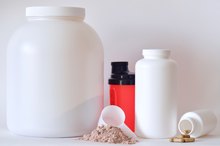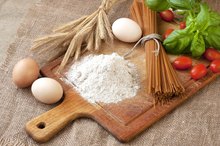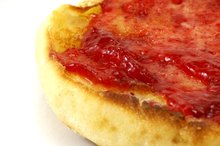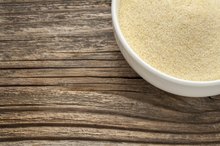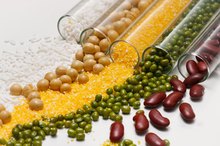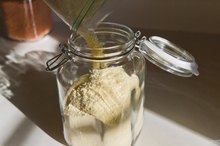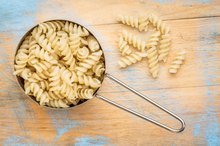Gluten Levels in Flour
Wheat flour contains a protein known as gluten. Flours are labeled differently in the store to reflect their varying gluten, or protein, levels. This helps you understand which flours to use for specific recipes. Using a flour with too little gluten can prevent your yeast breads from rising. If you use a flour with too much gluten for cakes or muffins, you might end up with heavy, dense baked goods, instead of light, delectable ones.
High-Gluten Flour
High-gluten flour, also called high-protein or strong flour, contains 13 to 14 g of protein per cup, making it 11.5 to 12.5 percent protein. It is best for yeast breads, pasta and pizza dough. The proteins in flour, when mixed with water or other liquid, bind together and stretch, creating layers that trap gasses made by yeast and creating a chewy texture. High-gluten flour may also be labeled as bread flour.
- High-gluten flour, also called high-protein or strong flour, contains 13 to 14 g of protein per cup, making it 11.5 to 12.5 percent protein.
- The proteins in flour, when mixed with water or other liquid, bind together and stretch, creating layers that trap gasses made by yeast and creating a chewy texture.
All-Purpose Flour
Does Rice Protein Contain Gluten?
Learn More
All-purpose flour varies from 9 to 12 g of protein per cup, or 9.5 to 12 percent, depending on the brand. All-purpose flour can be used for yeast breads, cream puffs and puff pastry. It contains a little too much protein for ideal pie crusts, muffins and pancakes. All-purpose flour comes in bleached and unbleached versions. Unbleached tends to have slightly higher protein levels, according to Shirley Corriher in her book “Cookwise.”
- All-purpose flour varies from 9 to 12 g of protein per cup, or 9.5 to 12 percent, depending on the brand.
- All-purpose flour can be used for yeast breads, cream puffs and puff pastry.
Self-Rising Flour
Self-rising flour contains leaveners, such as baking powder and baking soda. Per cup, self-rising has between 9 and10 g of protein, making it 9 to 10 percent protein. Self-rising flour cannot be used for yeast breads, but is appropriate for biscuits, quick breads and muffins.
Whole-Wheat Flour
Allergy to Sourdough Bread
Learn More
Whole-wheat flour contains the germ and the bran of the wheat kernel. Whole-wheat flour has less gluten than white flour because it contains the additional parts of the kernel that take up space. Yeast breads made with whole-wheat flour can be quite dense, so it is often mixed with white flour to create a lighter bread.
Southern Flours
Southern millers create flours with a light texture that weigh less per cup than other flours. They contain about 9 g of protein per cup, equaling 7.5 to 9.5 percent protein. Bakers swear by these light flours for flaky pie crusts, light biscuits and delicate quick breads and muffins.
Instant Flours
You find fine, instant flours in canisters in the flour section of the supermarket. These flours contain 9 to 10 g of protein per cup, or 9.5 to 11 percent protein. Rarely would you bake with one of these flours alone. Rather, use these flours to thicken sauces and gravy.
- You find fine, instant flours in canisters in the flour section of the supermarket.
- Rather, use these flours to thicken sauces and gravy.
Cake Flour
Cake flour has the lowest protein content of all flours with just 8 g or 7.5 to 8.5 percent. Cake flour turns out moist, light cakes, quick breads, muffins and pancakes. It absorbs less water than high-protein flours.
Related Articles
References
- The New York Times: Biscuit Bakers’ Treasured Mill Moves North
- "Cookwise;" Shirley O. Corriher; 1997
Writer Bio
Andrea Cespedes is a professionally trained chef who has focused studies in nutrition. With more than 20 years of experience in the fitness industry, she coaches cycling and running and teaches Pilates and yoga. She is an American Council on Exercise-certified personal trainer, RYT-200 and has degrees from Princeton and Columbia University.
